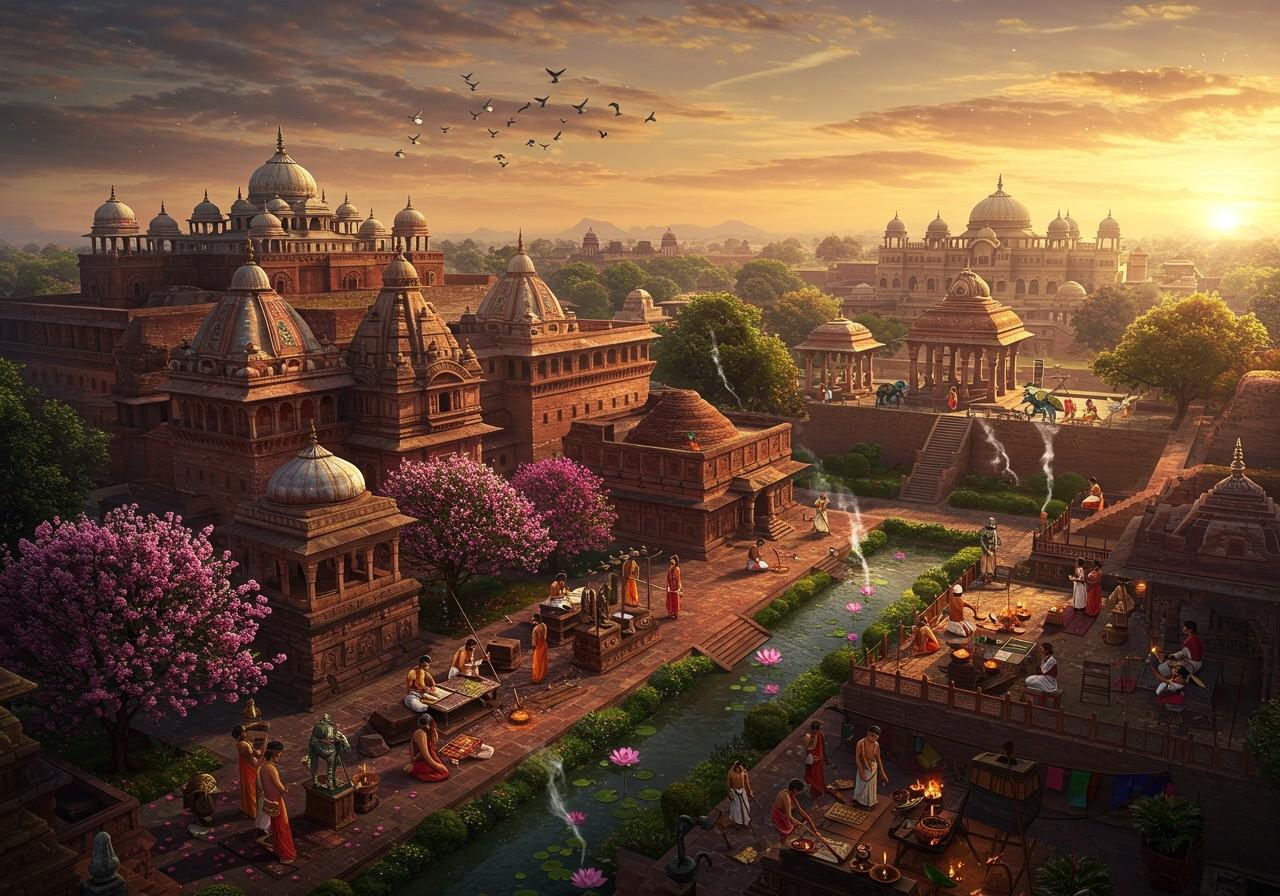
Magadha, a significant kingdom nestled in the eastern Ganges Plain, played a pivotal role in shaping India’s historical, spiritual, and cultural landscape. Its journey from a realm of myths to a dominant force during the Mahajanapadas period is a testament to its enduring legacy. Magadha’s influence continued through various dynasties, culminating in the rise of powerful empires like the Maurya and Gupta Empires. Texts like the Mahabharata and Buddhist scriptures further cement Magadha’s importance in the tapestry of Indian civilization.
Art and Architecture of Magadha
Magadha’s artistic and architectural heritage stands as a testament to its advanced civilization. Let’s explore the different facets of this rich heritage:
Mauryan Art (322-185 BCE)
- Ashokan Pillars: These pillars, erected by Emperor Ashoka, are renowned for their intricate carvings, often depicting edicts and symbols related to Buddhism and Dharma. They stand as enduring symbols of peace and righteous governance.
- Barabar Caves: These rock-cut caves showcase early Buddhist influences and demonstrate the architectural prowess of the Mauryan period. Inscriptions and the cave’s purpose as a meditation space for monks highlight the spiritual significance of the era.
Gupta Period Contributions (320-550 CE)
- Temple Architecture and Sculpture: The Gupta period witnessed significant advancements in temple architecture and sculpture, laying the foundation for later architectural styles. The intricate carvings and grandeur of these structures showcase the artistic achievements of the time.
- Nalanda University Ruins: The ruins of Nalanda University serve as a poignant reminder of its past glory as an ancient center of learning. The architectural innovation and the scale of the university complex speak volumes about the intellectual and cultural vibrancy of the Gupta era.
Influence of Buddhism
- Stupas and Monasteries: The rise of Buddhism in Magadha led to the construction of numerous stupas and monasteries, serving as vital centers for religious practice and scholarship. These structures often housed relics and served as pilgrimage destinations.
- Sculptures: Buddhist art flourished in Magadha, with notable sculptures like the Didarganj Yakshi showcasing the exceptional craftsmanship and spiritual depth of the period. These artistic creations embodied the teachings and principles of Buddhism.
Terracotta Art
- Decorative Tiles and Figurines: Terracotta art flourished in Magadha, with decorative tiles and figurines adorning homes and temples. These pieces often depicted scenes from daily life, religious narratives, and mythical creatures, offering a glimpse into the cultural and spiritual world of the time.
- Artistic Expression: Terracotta art also served as a medium for artistic expression, allowing artisans to showcase their skills and creativity through intricate designs and vibrant colors. The versatility of terracotta allowed for a wide range of artistic creations, from simple toys to elaborate architectural ornaments.
Festivals and Celebrations of Magadha
Magadha’s vibrant cultural heritage is reflected in its diverse festivals and celebrations:
Chhath Puja
This major festival dedicated to the Sun God features unique rituals performed at riversides, where devotees offer prayers and express gratitude. Chhath Puja holds immense cultural significance for the people of the region.
Pitrupaksha Mela
Held in Gaya, this mela is dedicated to honoring ancestors. Families gather to perform rituals for their departed loved ones, seeking blessings and peace. Pitrupaksha Mela is a testament to the importance of ancestral reverence in Magadha’s cultural fabric.
Other important festivals include Buddhist festivals like Vesak, Jain festivals such as Mahavir Jayanti, and widely celebrated festivals like Holi and Diwali, each contributing to the rich tapestry of Magadha’s cultural heritage.
Magadha’s Influence on Indian Culture
Magadha’s cultural contributions have left an indelible mark on Indian society, shaping its spiritual, intellectual, and artistic landscape. The rise and spread of Buddhism and Jainism, the development of governance systems, and advancements in language, literature, and culinary traditions all bear the imprint of Magadha’s influence.
Poojn.in: Connecting You to India’s Spiritual Heritage
Poojn.in, India’s leading online store for cultural and religious goods, offers a wide selection of products to help you connect with India’s rich spiritual traditions, including those rooted in the historical significance of Magadha. Whether you’re seeking authentic puja items, traditional ritual kits, sacred worship materials, ceremonial decorations, or spiritual books, Poojn.in provides a convenient platform to access these items while honoring their traditional significance. Explore our collection today and discover how you can enrich your spiritual practices with the essence of Magadha’s cultural heritage.
Here are some specific product categories relevant to the cultural heritage discussed:
- Radha Krishna Bigraha: Beautiful sculptures for worship, reflecting the artistic traditions of the region.
- Maa Laxmi & Lord Ganesha Murti: Exquisite murtis for your puja room, crafted with traditional techniques.
- Pure Arjun Chal: High-quality natural products for your rituals and ceremonies.
Conclusion
Magadha’s cultural legacy continues to resonate in modern India, reminding us of the enduring power of tradition, art, and spirituality. By preserving and celebrating this rich heritage, we ensure that the spirit of Magadha continues to inspire and enrich the lives of generations to come.


